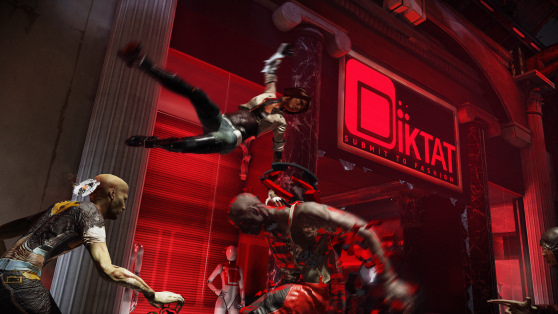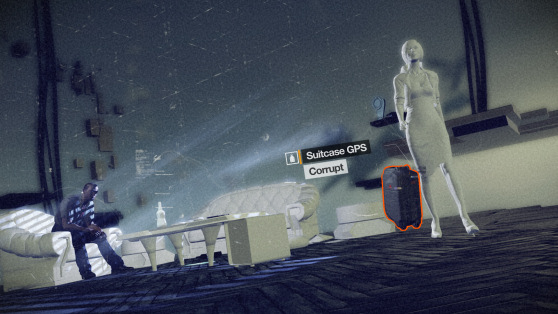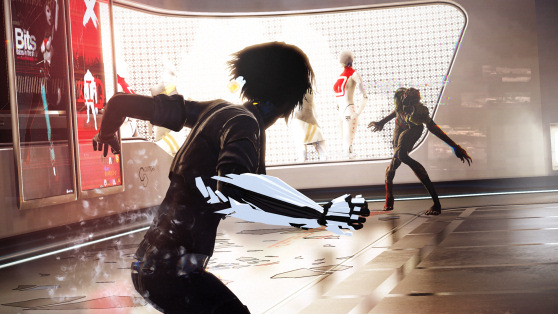What you won’t like
Identity confusion
As mentioned, Remember Me borrows elements from Rocksteady Studios’ Batman series. In addition to Sensen Fury, the way you leap over enemies to avoid their hits — telegraphed by exclamation points over their heads — is the same. Players can’t counter moves, but they can evade them without interrupting the flow of combat. That way Nilin can, like Batman, confront a whole room of enemies with style and finesse.
The game also dips into the kind of climbing segments that you’d find in Uncharted or the recent Tomb Raider. You shimmy across ledges, climb or slide down ladders, and jump between platforms. Nilin conveniently catches herself if you accidentally run off an edge, so you won’t fall to your doom. Sometimes the game even forces you to sprint across rooftops or inside buildings as they collapse around you due to gunfire or other hazards.
Unfortunately, that can diminish Remember Me’s attempts to establish its own identity as a property. While the Combo Lab and Neo-Paris are both rich and unique, the actual presentation of combat is unmistakably Batman, and the environments are strictly linear. You can’t explore nearly as much as you’d like to.
The game does try to mix up the jungle-gym parts by sprinkling in some obstacles, including electrified pools of water and electronic billboards that you can only cross when their panels have finished flipping (otherwise, they’ll push you off). These aren’t enough, though, to curb occasional boredom and a slow pace.
Fighting can become tedious in the more droll boss showdowns, which rely too much on the effects of a single S-Pressen (which has to recharge after a cooldown period) or fighting throwaway enemies such as the mutant-like Leapers, which you can spam-kill to refill your Focus and regenerate health. One sequence near the end of the game was absolutely brutal and caused the game to glitch out when I finally finished. It still thought I was in battle mode. The background music stopped playing, and I couldn’t interact properly with objects.
While you can continue your combo midway if you vault over enemies, too many bodies crammed together onscreen can prevent you from landing any hits at all. You’ll be too busy trying to somersault to safety or roll out of danger.
And although Pressens are fun to experiment with, executing the actual combos feels routine since you’re only pressing the same four sequences over and over.
Remixing memories
One way that Remember Me does find its own identity amidst its copycat actions is through memory remixes. Even though these puzzles become easier later on, the worst challenge is the first one you encounter, and it can easily turn you off for good.
Basically, players enter another person’s memory and watch a scene unfold. Once it’s over, you obtain an objective and can rewind and fast-forward the memory, activating certain glitches to change events in that person’s mind. This can turn your enemies — like a bounty hunter who’s out for blood — into allies.
The first time I experienced one of these remixes, the game didn’t adequately prepare me for the task. I didn’t think to pay attention to the clues that might show me how to best influence the actions in the scene (such as lifting the safety on a gun or cracking a windshield), and I didn’t know that the best approach was to rewind the memory to the very beginning. This remix was also one of the longest. The shorter ones are much easier to tinker with correctly.
It’s a cool idea, and it’s fun seeing how you could tamper with someone’s recollections to produce alternate scenarios. But these are sometimes time-consuming as you continuously twirl the left stick on the controller, trying to catch the smallest glitch. Remember Me contains a handful of remixes, which is both a boon (you only have to endure a few) and a curse as these are some of the game’s most interesting aspects.
Forever loading
Remember Me has fair and rather excellent checkpoints, even in boss battles, and it desperately needs them. The load times are awful. Developer Dontnod added in-game tips that you can cycle through with a press of the Y button, but you’ll still be counting the seconds until you can resume playing.
The delay is particularly annoying when you die several times in quick succession. Have fun with that.
Pieces of history
As much as I wanted to explore Neo-Paris, the game stuck me on a fixed path. So it might be good, then, that I can at least learn about its history by collecting Mnesist Memories, documents that tell me about landmarks, people, technology, and important events.
Only I didn’t care to read paragraph upon paragraph of text in tiny print, so these weren’t worth the effort.
Conclusion
Remember Me is a game of ups and downs. It’s sometimes frustrating and sometimes monotonous, but it also transports you to an amazing world with striking designs, a deep culture, and interesting characters. The game might rely a little too heavily on “been there, done that” elements of play, but when it breaks from the norm — and it does so often — it hands players power and a sense of freedom in experimentation.
If I remember anything about Remember Me years from now, it’ll be how much I loved playing with its technology and exploring its themes of memory — its place in our lives and how, with even the slightest tug, we can change everything. Hate can disappear. Love can thrive. Or a whole society can fall to pieces.
Well, I’ll remember those things and those adorable little robot floor cleaners that paused politely every time I stepped near them.
Score: 70/100
Remember Me releases for the Xbox 360, PlayStation 3, and Windows PC on June 4, 2013. The publisher provided GamesBeat with an Xbox 360 copy of the game for the purpose of this review.
VentureBeat's mission is to be a digital town square for technical decision-makers to gain knowledge about transformative enterprise technology and transact. Learn More





















